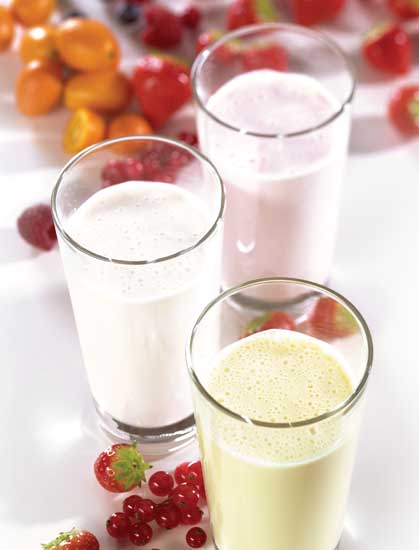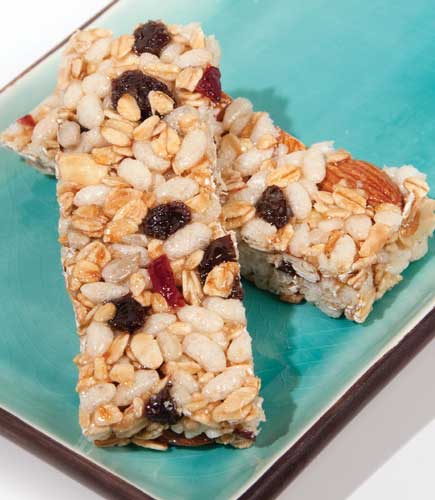Flexible and Functional
NUTRACEUTICALS
Bone and joint health isn’t just a concern for the aging population. For weekend warriors and serious athletes, pain-free movement and recovery are important. For those suffering from arthritis at any age, pain relief is a priority. Developing strong bones as well as maintaining bone density is important for people of all ages.
 “An increasingly aging as well as active population is the key factor driving interest in bone and joint health. People are living longer and doing more or wanting to do more physical activity later into life, everything from leisurely golf games to extreme sports such as triathlons and competitive running,” observes Samantha Ford, business development manager at AIDP. “However, as we age, our lifestyle, diet, and environment can put our bodies through quite a bit of wear and tear, and the body isn’t working as optimally in later life and breaks down more easily when stressed. A high-quality supplement can provide the support needed to maintain the necessary level of health and fitness.”
“An increasingly aging as well as active population is the key factor driving interest in bone and joint health. People are living longer and doing more or wanting to do more physical activity later into life, everything from leisurely golf games to extreme sports such as triathlons and competitive running,” observes Samantha Ford, business development manager at AIDP. “However, as we age, our lifestyle, diet, and environment can put our bodies through quite a bit of wear and tear, and the body isn’t working as optimally in later life and breaks down more easily when stressed. A high-quality supplement can provide the support needed to maintain the necessary level of health and fitness.”
Glucosamine and chondroitin, two components found in cartilage, have been the top supplements sought after for joint health. People suffering from osteoarthritis use these for pain relief. Calcium and vitamin D as well as lowfat dairy foods have always been top nutrients for bone health. Laird et al. (2017) recently observed significant positive associations between the frequencies of yogurt intake with measures of bone density, bone biomarkers, and indicators of physical function in a community of older adults.
Here is a breakdown of some of today’s bone and joint health ingredients.
Collagen
Collagen is popular in the beauty foods realm for its skin and nail benefits. However, as a component of cartilage, collagen is also popular in the joint and bone health market. “While for many, calcium was the go-to for bone health, new research shows that a calcium/collagen combination for strength and flexibility is ideal,” says Ford. “The need for more support in this area is driving research and innovation.”
AIDP offers several ingredients to support mobility and joint health. KoAct, a patented chelate of collagen and calcium, helps improve bone mineral density, bone strength, and flexibility. “Bone mass is made up of 75% calcium and inorganic minerals and 25% collagen,” explains Ford. The collagen component is critical to bone structure and function because it helps keep bones flexible and able to absorb impact, especially during physical activity, she notes. “KoAct’s patented composition drives collagen to the bone matrix, providing a stronger, more flexible bone,” Ford adds. Elam et al. (2015) demonstrated that KoAct is beneficial for reducing bone loss in postmenopausal women with osteopenia.
Another AIDP ingredient, KollaGen II-xs is a specialized type II collagen designed to support joint health, including range of motion, flexibility, and overall joint comfort. It is produced from avian sternum through a proprietary, solvent-free technology. “KollaGen II-xs provides all of the major components of joint cartilage—55%–70% collagen type II along with chondroitin, glucosamine, and hyaluronic acid—in a ratio similar to what’s naturally present in our bodies, providing a synergistic effect on joint health and function,” says Ford. Pereira Lopes et al. (2016) demonstrated the safety and efficacy of KollaGen II-xs in reducing joint discomfort as well as improving range of motion and muscle strength.
GELITA offers collagen peptides for both bone and joint health. FORTIBONE was developed to promote bone health, increasing bone density and reducing degradation processes. The specific peptides of FORTIBONE stimulate bone cells to increase the synthesis of bone components such as collagen. It also influences degenerative processes in bones by reducing osteoclast activity, resulting in a higher synthesis of collagenous bone matrix. FORTIGEL aids in regenerating joint cartilage. Optimized specific collagen peptides of FORTIGEL have been proven to activate the growth of new cartilage by stimulating cells, helping to ease joint discomfort and make the joints smooth and mobile.
Rousselot offers Peptan collagen peptides, which are optimized for high bioavailability and activity. The type I collagen peptides are easily digestible. In a model that mimics the loss of bone mass in postmenopausal women, Dar et al. (2017) showed that a daily dose of Peptan for three months, in addition to a normal diet (with adequate levels of calcium, protein, and vitamin D), helped to restore bone mineral density and bone strength.
Eggshell Membrane
Eggshell membrane is a newer ingredient promoted for joint health. Stratum Nutrition offers NEM (natural eggshell membrane), which recently was shown to improve recovery from exercise-induced joint pain and stiffness. NEM is GRAS and contains naturally occurring hyaluronic acid, chondroitin, and glucosamine, three types of collagen, peptides, and amino acids. Ruff et al. (2018) found that taking a 500 mg dose of NEM once a day improved recovery from exercise-induced joint pain and stiffness and significantly reduced discomfort immediately following exercise.
In addition to collagen, AIDP offers TendoGuard, a proprietary (patented) dietary supplement formula that provides a blend of 100% avian eggshell membrane and sternum cartilage to support healthy mechanical properties of connective tissue. TendoGuard contains a perfect balance of collagen type I, type II, type V, type X, hyaluronic acid, chondroitin sulfate, and mucopolysaccharides—nutrients critical to collagen synthesis and flexible, lubricated joints and connective tissues.
Prebiotics
“One of the most surprising and well-studied areas is the role of prebiotics like chicory root fiber in enhancing calcium absorption to improve bone mineral density,” says Taylor Halstead, product manager for specialty carbohydrates at Cargill. “Scientists have also worked to confirm that consuming fructooligosaccharides (FOS) increases calcium absorption in adolescent boys and girls.” Halstead explains that a study by Abrams et al. (2005) that involved supplementing pubertal adolescents’ high-calcium diet with 8 g of inulin-type fructans/day showed a significant increase in calcium absorption at eight weeks and a significant increase in whole-body bone mineral density after one year, compared with the group taking a placebo. Additionally, increased calcium and magnesium absorption has been observed in postmenopausal women after six weeks of treatment with FOS (10 g/day) (Holloway et al. 2007).
 Cargill offers Oliggo-Fiber chicory root fiber. It can support healthy bones by boosting calcium absorption in certain subgroups of the population, particularly pre-teenage girls and postmenopausal women. “This enhanced calcium absorption occurs in the large intestine rather than the stomach or small intestine,” explains Pam Stauffer, global marketing programs manager at Cargill. “As a result of fermentation, short-chain fatty acids are produced which lowers the pH of the intestine. This environment solubilizes the calcium, making it more available.”
Cargill offers Oliggo-Fiber chicory root fiber. It can support healthy bones by boosting calcium absorption in certain subgroups of the population, particularly pre-teenage girls and postmenopausal women. “This enhanced calcium absorption occurs in the large intestine rather than the stomach or small intestine,” explains Pam Stauffer, global marketing programs manager at Cargill. “As a result of fermentation, short-chain fatty acids are produced which lowers the pH of the intestine. This environment solubilizes the calcium, making it more available.”
BENEO offers an oligofructose-enriched inulin, Orafti Synergy1. Its chain length pattern has been found to be particularly efficient in enhancing the bioavailability of calcium in the diet and supporting calcium absorption. The bacterial fermentation of Orafti Synergy1, which is naturally extracted from chicory, increases the absorption capacity for calcium by extending the absorption capacity to the large intestine.
Vitamins and Minerals
Manoy et al. (2017) demonstrated that vitamin D2 supplementation for six months reduced oxidative protein damage, decreased pain, improved quality of life, and improved grip strength and physical performance in knee osteoarthritis patients. The 175 patients with low levels of serum 25-hydroxyvitamin D received 40,000 IU of vitamin D2/week for six months.
NattoPharma ASA offers MenaQ7 vitamin K2 as menaquinone-7 (MK-7). It has been shown to improve vitamin K status and increase the activation of osteocalcin, the K-dependent protein responsible for binding calcium to the bone mineral matrix, benefiting bone health. Karpinski et al. (2017) reviewed the role of vitamin K in combination with vitamin D and other factors in bone health. “An important part of the mechanism of vitamin K involves carboxylation and posttranslational activation of the family of vitamin K–dependent proteins, which prevent expression of pro-inflammatory factors and support improvement in bone mineral concentration, bone mineral density, and the quality of bone matrix,” write the researchers.
Veronese et al. (2017) showed that higher dietary magnesium intake has a protective effect on future osteoporotic fractures, especially in women with a high risk for knee osteoarthritis. The researchers investigated magnesium intake and the onset of fractures in a large cohort of American men and women involved in the Osteoarthritis Initiative over a follow-up period of eight years. Women meeting the recommended magnesium intake were at a 27% decreased risk for future fractures.
 Botanicals
Botanicals
Highlighting the power of botanicals, Carlson Laboratories in early 2018 introduced Enhanced Mobility, a botanical supplement for joint support. The dietary supplement is a blend of four unique joint health nutrients: boswellia, curcumin, ginger, and tart cherry. ApresFlex AKBA boswellia extract promotes joint and connective tissue health. CurcuWIN enhanced curcumin extract supports joint health and flexibility. Gingever ginger is an antioxidant that protects joints from free radical damage. CherryPURE tart cherry provides the antioxidant power of proanthocyanidins, which help protect the body from free radicals and promote joint and muscle health.
Lopez et al. (2017) evaluated the effects of a standardized aqueous extract of Terminalia chebula fruit (AyuFlex from Natreon) dietary supplementation on joint mobility, comfort, and functional capacity in healthy overweight subjects. One hundred and five overweight male and female subjects (35–70 years of age) were prescreened and randomized to one of three groups: placebo, 250 mg of AyuFlex twice daily, or 500 mg of AyuFlex twice daily. The results showed that taking AyuFlex improved knee joint discomfort with activity/exercise, overall whole-body joint function, and knee soreness following leg extension resistance exercise. The differences between those who took 250 mg of AyuFlex and 500 mg of AyuFlex were nonsignificant for most of the outcome measures.
Montmorency tart cherries are rich in phenolic compounds, specifically anthocyanins, which have been shown to fight inflammation related to arthritis and gout. Kuehl et al. (2012) found that subjects who drank 10.5 oz bottles of Montmorency tart cherry juice twice daily for 21 days experienced a significant reduction in serum biomarkers of inflammation. The researchers concluded that Montmorency tart cherry juice may be an effective way for osteoarthritis patients to manage their disease.
Next month’s Nutraceuticals column will discuss ingredients used to formulate snacks positioned as better-for-you.
 Linda Milo Ohr,
Linda Milo Ohr,
Contributing Editor
Denver, Colo.
[email protected]
References
Abrams, S. A., I. J. Griffin, K. M. Hawthorne, L. Liang, S. K. Gunn, G. Darlington, and K. J. Ellis. 2005. “A Combination of Prebiotic Short- and Long-chain Inulin-type Fructans Enhances Calcium Absorption and Bone Mineralization in Young Adolescents.” Am. J. Clin. Nutr. 82: 471–476.
Dar, Q., E. M. Schott, S. E. Catheline, et al. 2017. “Daily Oral Consumption of Hydrolyzed Type 1 Collagen is Chondroprotective and Anti-inflammatory in Murine Posttraumatic Osteoarthritis.” PLoS ONE. 12(4): e0174705. doi: 10.1371/journal.pone.0174705.
Elam, M. L., S. A. Johnson, S. Hooshmand, et al. 2015. “A Calcium-collagen Chelate Dietary Supplement Attenuates Bone Loss in Postmenopausal Women with Osteopenia: A Randomized Controlled Trial.” J. Med. Food. 18(3): 324–331.
Holloway, L., S. Moynihan, S. A. Abrams, K. Kent, A. R. Hsu, and A. L. Friedlander. 2007. “Effects of Oligofructose Enriched Inulin on Intestinal Absorption of Calcium and Magnesium and Bone Turnover Markers in Postmenopausal Women.” Br. J. Nutr. 97: 365–372.
Karpinski, M., J. Popko, K. Maresz, V. Badmaev, and S. J. Stohs. “Roles of Vitamins D and K, Nutrition, and Lifestyle in Low-Energy Bone Fractures in Children and Young Adults.” J. Am. Coll. Nutr. 36(5): 399–412.
Kuehl, K. S., D. L. Elliot, A. E. Sleigh, and J. L. Smith. 2012. “Efficacy of Tart Cherry Juice to Reduce Inflammation Biomarkers among Women with Inflammatory Osteoarthritis (OA).” J. Food Studies. 1(1). doi: 10.5296/jfs.v1i1.1927.
Laird, E., A. M. Molloy, H. McNulty, et al. 2017. “Greater Yogurt Consumption is Associated with Increased Bone Mineral Density and Physical Function in Older Adults.” Osteoporosis International. 28(8): 2409–2419.
Lopez, H. L., S. M. Habowski, J. E. Sandrock, et al. 2017. “Effects of Dietary Supplementation with a Standardized Aqueous Extract of Terminalia chebula fruit (AyuFlex) on Joint Mobility, Comfort, and Functional Capacity in Healthy Overweight Subjects: A Randomized Placebo-controlled Clinical Trial.” BMC Complementary and Alternative Medicine. 17: 475.
Manoy, P., P. Yuktanandana, A. Tanavalee, W. Anomasiri, S. Ngarmukos, T. Tanpowpong, and S. Honsawek. 2017. “Vitamin D Supplementation Improves Quality of Life and Physical Performance in Osteoarthritis Patients.” Nutrients. 9(8): 799.
Pereira Lopes, A., B. Souza Bagatela, F. L. A. Fonseca, S. Morten, J. Gu, and F. Ferreira Perazzo. 2016. “A 30-day Clinical Investigation of the Safety and Efficacy of KollaGen II-xs, a New Avian Sternal Collagen Type II Hydrolysate.” HealthMED. 10(2): 89–92.
Ruff, K. J., D. Morrison, S. A. Duncan, M. Back, C. Aydogan, and J. Theodosakis. 2018. “Beneficial Effects of Natural Eggshell Membrane Versus Placebo in Exercise-induced Joint Pain, Stiffness, and Cartilage Turnover in Healthy, Postmenopausal Women.” Clin. Interv. Aging. 13: 285–295.
Veronese, N., B. Stubbs, M. Solmi, and M. Noale. 2017. “Dietary Magnesium Intake and Fracture Risk: Data from a Large Prospective Study.” Brit. J. Nutr. 117(11): 1570–1576.


